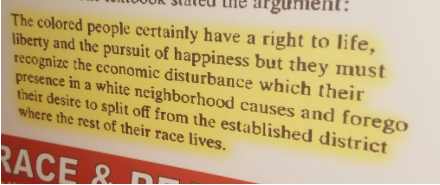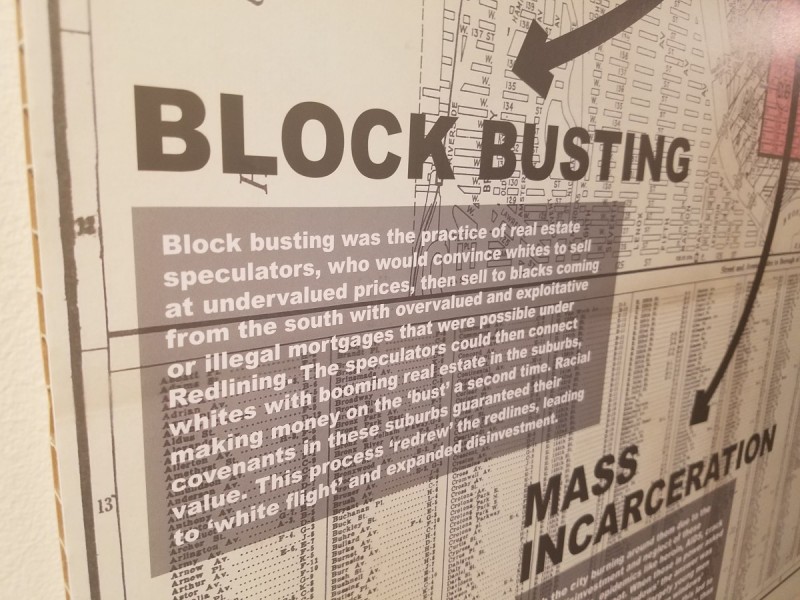Three things you need to know to get land-use woke

A redlining map of Baltimore. Unless otherwise noted, all images taken at the UnDesign the Redline exhibit. Image by the author.
Increasingly our national dialogue about housing affordability is looking at land use as both the problem and the place for solutions. America’s history of land use is fundamentally racist, exclusionary, and exploitative, and if we’re going to have conversations about where to go in this policy space, we need to discuss what got us here.
Last month, affordable housing nonprofit Enterprise Community Partners sponsored a touring temporary exhibit called UnDesign the Redline at the Pepco Edison Place Gallery in DC. The curators present a damning narrative of American land-use history, one where federal and local governments, private industry, and community/neighborhood groups systematically and routinely disenfranchised people of color through land-use tools over the last few centuries.
The exhibit gets its name from redlining, the federally inspired practice from the 1930s-60s of labeling neighborhoods based on the “riskiness” of issuing homeowner loans there. Of course, those boundaries were explicitly racially drawn, and loan seekers in neighborhoods of color could not qualify for the same loans that white homeowners were applying for and receiving.
In fact, the exhibit is about much more than just redlining and presents an expansive view of land-use history, going all the way back to the genocide and subsequent theft of land from Native Americans.
Land use has and continues to be a tool that “perpetuates and reflects the deep divide of racism” and economic inequity, says curator April DeSimone. “This is about finding ways to devalue the land and property where people of color live… to make skin color synonymous with the devaluation of property.”
Over the years there have been many tools to do just that.
There was a lot to take in at this exhibit, but here are some key historical (and current) practices and terms you should know about to become a little more land-use woke:
Redlining - Then:
Starting in the 1930s, the Home Owner’s Loan Corporation was asked by the federal government to draw up maps of the US’ major cities, asking local realtor surveyors to designate neighborhoods into categories: “Best,” “Still Desirable”, “Declining” and “Hazardous” (the last was colored red).
These boundaries were racially drawn and typically inner city, minority-majority neighborhoods were the ones redlined, or designated as “Hazardous.” The realtors contracted to do this were in keeping with explicitly racist real estate practice of the day, as noted in the National Association of Real Estate Boards in their 1934 code of ethics:
“a realtor should never be instrumental in introducing into a neighborhood…members of any race or nationality… whose presence will clearly be detrimental to property values in that neighborhood” (as quoted in The Color of Law, Rothstein, 2017)
These categories were used by lenders when they issued federally-backed loans, which of course meant neighborhoods labeled red did not have the same access to these loans or other federal homeownership programs such as the GI Bill. That meant, for example, that if you were a returning veteran living in a redlined area, lenders would not offer you the accompanying 0 percent interest loans because your neighborhood was deemed too risky for investment.
If your city did not have a redlining map, the Federal Housing Administration still used racist criteria to evaluate the risk of your loan, as seen in the quote below from the agency’s underwriting manual from 1936 (emphasis mine):
233. The Valuator should investigate areas surrounding the location to determine whether or not incompatible racial and social groups are present, to the end that an intelligent prediction may be made regarding the possibility or probability of the location being invaded by such groups. If a neighborhood is to retain stability it is necessary that properties shall continue to be occupied by the same social and racial classes. A change in social or racial occupancy generally leads to instability and a reduction of values.
Redlining - Now:
Beyond strangling the flow of loan money to the redlined neighborhoods, this practice set up a pattern of decades of disinvestment; many of those same redlining neighborhoods have still not recovered.
The exhibit shows that even though redlining was eventually outlawed, the racist beginnings of the practices created “systems of society [that] had become structurally racist” and “these structural conditions largely remain”.
Comedy show host Adam of Adam Ruins Everything reiterates this point in his video about redlining and the suburbs: the effects of this practice set up a structural system of disinvestment in some areas (primarily where people of color live) and increased investment and opportunity in others (where primarily white people live).
In DC, GGWash has also written about the persistence of problematic language around “stable neighborhoods”. Take a look at the DC maps that continue to use the “stable” neighborhood categories to codify areas and assign policies.
Racial covenants, deeds and zoning- Then:
Explicit language was written into home deeds or neighborhood covenants preventing the sale or rental of that property to people of color.
Excerpt from a deed restriction of Pinehurst, Florida, 1926 Image by W. Kiernan licensed under Creative Commons.
DC has a particular history of this, as described by the work of Prologue DC and GGWash contributor Sarah Shoenfeld. These practices were ruled illegal through a Supreme Court case in 1948, but were still widely enforced until the 1968 Fair Housing Act.
Racial covenants, deeds and zoning - Now:
These practices were challenged in court and finally outlawed in 1968, but many of these documents still exist today (though obviously are not enforceable). As recently as last month residents in a neighborhood in Towson discovered racially restrictive covenants still on the books for their neighborhood.
While perhaps no longer explicitly racist, we still see exclusionary zoning and land use practices today. There are a number of tools a powerful set of neighbors can use to exclude others from their neighborhood, from zoning to land use policy to specious historic preservation cases.
In DC opponents to a new homeless shelter in Ward 3 have been appealing and delaying the building for over a year through zoning challenges, fervently claiming over and over again that this is not about keeping those people out. Other efforts are less direct but still effective, such as fighting to keep out accessory dwelling units or apartment buildings in single family neighborhoods.
Block Busting - Then:
The exhibit argues that segregationist beliefs and attitudes created a racist financial reality that attached the devaluation of property to the presence of black and brown people. “White flight” is a commonly known process where white neighbors moved out of city neighborhoods en masse when black neighbors moved in, quickly and dramatically flipping the demographics of some areas.
Far from a “natural” process, real-estate speculators would facilitate these flights through block busting: convincing whites to sell their properties under market value because blacks were moving in (which according to published real estate guidelines of the time, had a destabilizing effect on land values).
Published in the 1922 Principles of Real Estate Practice, a training manual put out by the National Association of Real Estate Brokers (NAREB). Image by the author.
Those same speculators would then sell those same homes to black families moving in, but at tremendous markup and often with mortgages or contracts that were exploitative. Because redlining made federally backed loans harder to obtain in these neighborhoods, loan options were fewer for people of color and speculators often got away with offering them contracts that had illegal stipulations, such as clauses that allowed the speculator to take the entire home if the owner missed one payment.
Block Busting - Now:
Today many of these practices are illegal, but the practice of “racial steering” and the existence of an “entrenched dual-housing” market for people of color persists today. Last fall, the Department of Housing and Urban Development (HUD) actually issued a warning letter to DC about these issues, saying that the city was not doing enough to battle these practices and the patterns of segregation they reflect and deepen.
We need to address these issues, the exhibit consistently argues, because the lasting effects of these actions in generations past contribute to huge racial wealth gap we see today. The benefits white families received (and the barriers black families faced) from generations ago set up a wealth inequity that has persisted and worsened over decades.

_800_600_90.jpg)
_800_600_90.jpg)

